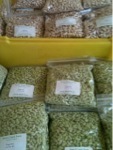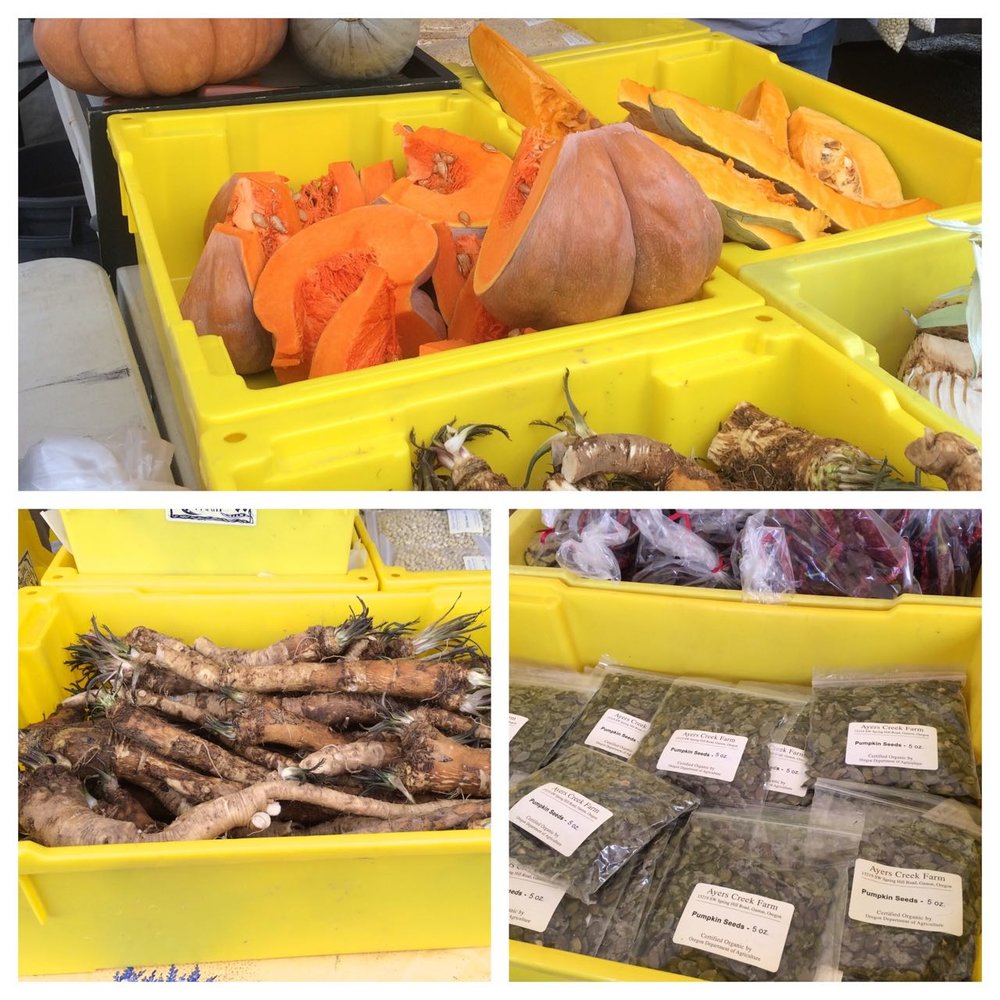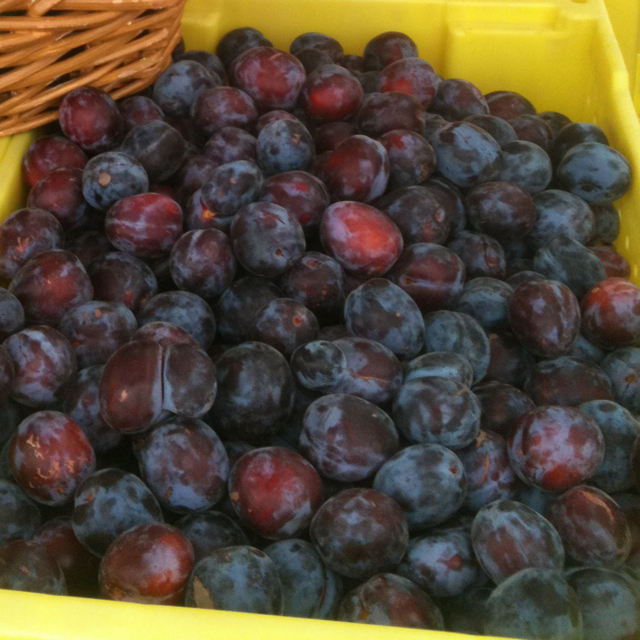Ayers Creek Farm Newsletter November 11 2012
Guest User
 This Sunday will mark the 200th time we have set up our tent at the Hillsdale Farmers' Market, and the 200th time we have sent out a newsletter announcing our presence there. Thee newsletter started as a simple invitation to friends and fellow activists telling them about the new market in Hillsdale and what we hoped to bring, and it evolved from there. Even with this many performances, we still suffer from the vendors' version of stage fright the night before market, fretting that we might forget something, oversleep, run out of change, or nobody will come because of some much more important event. Around 3:00 am we start waiting for the 5:00 alarm. By 10:00 when the bell rings we are pulled together enough to start the day, and our stage fright dissipates.
This Sunday will mark the 200th time we have set up our tent at the Hillsdale Farmers' Market, and the 200th time we have sent out a newsletter announcing our presence there. Thee newsletter started as a simple invitation to friends and fellow activists telling them about the new market in Hillsdale and what we hoped to bring, and it evolved from there. Even with this many performances, we still suffer from the vendors' version of stage fright the night before market, fretting that we might forget something, oversleep, run out of change, or nobody will come because of some much more important event. Around 3:00 am we start waiting for the 5:00 alarm. By 10:00 when the bell rings we are pulled together enough to start the day, and our stage fright dissipates.
We have wanted to schedule a field day during the autumn harvest, but the timing is difficult because of the mountain of tasks we face in October and November. As good substitute, Cooking Up A Story has a couple of videos filmed at Ayers Creek as part of their food•farmer•earth series: http://cookingupastory.com/ The series is put together by Rebecca and Fred Gerendasy, assisted by Kathleen Bauer of GoodStuffNW, and covers many interesting subjects. Hillsdale's market chef and pop-up restaurant star, Kathryn LaSusa Yeomans, is also featured. If you subscribe to the series, you will be sure to see Kathryn's upcoming rutabaga and ginger soup episode.
So, for the 200th time (hope this is not getting tedious for you) here is what we are bringing to Hillsdale:
Cornmeal: Roy's Calais Flint and Amish Butter. As usual, we will also have some whole kernels of the flint with slack lime available for hominy.
Pulses: dry garden beans (see below) and chick peas.
Cayenne Peppers: whole dried.
We have Joe's Long and Aci Sivri. These two cayennes are large for the type and fall into the mildly to medium hot when the seeds and ribs are removed. The heat is very pleasant, allowing you to enjoy the excellent flavor. They are substantially hotter when used whole. Interestingly, the heat of these peppers lingers pleasantly in the cheeks and neck for a long time. Aci Sivri is a Turkish pepper that has been grown in the valley for at least the two decades and is well-adapted to this climate. Joe's Long was cultivated Joe Sestino of Troy, New York, and is of Italian origin, and also well adapted.
This year, we have two small cayennes as well. They are much hotter; the heat is sharp and up front in the mouth, and the forehead. These are the traditional peperoncini of Calabria and Campania. As often happens, the cultivators are of differing opinions regarding regarding the subtle differences in flavor. Our now classic debate between the lump them into a landrace (Anthony) and split them into distinct varieties (Carol) points of view.
Garlics and Shallot: We will have our population of hard necks (lumper prevails) and the grey shallot. We will also have some onions.
Horseradish: The Bohemian parmesan. Freshly gated, this precious improves all manner of dishes from soup to salad. And for the very best Bloody Mary or Bull Shot, only freshly gated horseradish will do, so why be disappointed.
Potatoes aka spuds
Winter Squash: Return of the big ones. Musqueé is the classic market squash with dark orange flesh found through Europe, and sometimes exceeds 40 pounds per fruit. Sibley is a lighter, slightly citrusy, banana-type squash that was formerly grown extensively in the western United States as a processing squash, but has been supplanted by the heavy flavored and higher yielding Kabocha types.
Greens: Endive, escarole and rocket. The first of the chicories to develop are endive and escarole. They have the crisp texture of lettuce and are excellent as a salad green. They are also a good olera, or cooking green. In New England where there are many Portuguese fishing communities south of Boston, Progresso soup markets a canned chicken and escarole soup. Rocket is an excellent soup green, as well as adding a pungent snap to salads.
Preserves: Still a limited selection until we make our annual pilgrimage to Sweet Creek Foods. Logistics have delayed our processing this year. If you scroll down a bit, the food•farmer•earth series has two videos of Sweet Creek Foods and its beloved glassery master Paul Fuller. You will see why we cherish our preserve making days in Elmira.
Almost forgot,
Apples: Cox's Orange Pippin and some leather coats. Not just certified organic, but also naturally certified, so you be sharing it with another creature. Don't worry, arthropods have a modest appetite and these are very old varieties, so you will have the same experience as Will Shakespeare, Thos. Jefferson, Jane Austin, Louisa May Alcott or Samuel Pepys when they ate these apples. Few growers are nervy enough to make that claim . . . If it doesn't sound appealing, go eat a 'Pink Lady' or 'Honeycrisp' because we will eat any that are leftover, the food for great ideas.
___________________________________________
Our Bean Primer
Dried legumes have a relatively short life. Typically, after two years, chickpeas and garden beans become stale and eventually they may not even soften up no matter how much they are cooked. They are in their prime for six months after harvest, and good for a year. The bean is a seed and the two halves within the seed coat are storage leaves bridged by a stalk supporting the root and shoot which will grow into the plant. The cotyledons store a mixture of carbohydrates (long chains of sugar molecules) and proteins (long chains of amino acids) that were originally formed in special seed tissue called the endosperm. In grains, the endosperm is retained, but in legumes and many other plants, it is entirely absorbed into the cotyledons. This repackaging of these long molecules apparently makes them vulnerable to tangling, sort of like the way that elastic bands, string and paper clips left in a drawer will eventually form a knotted mass. As the carbohydrates and proteins get tangled up they become harder and then impossible to separate into digestible units by heat or enzymatic action. This repackaging problem is probably why beans have a shorter shelf life than grains.
We always soak our legumes overnight or a bit longer. As the seed draws in water, enzymes are released which start to chop apart its proteins and carbohydrates into smaller units. In our experience, allowing the seed's natural enzymes to start the process yields a sweeter and smoother cooked bean. The next day, we drain off the soaking water. Seeds must germinate in a relatively hostile environment. To fend off hungry invertebrates, fungi and bacteria, they release nasty compounds that make life unpleasant for these creatures and us. There is a myth that the soaking water contains valuable nutrients; taste it and decide for yourselves. We dump the water, rinse the beans and start cooking them in fresh water.
Beans cook best in a nearly neutral pH, which makes water the best cooking medium. In some areas, it is customary to add a pinch of "soda" to raise the pH of the water. Acidic ingredients such as tomatoes should be added after the beans are cooked. Some people believe salt impedes the cooking of beans. Whether or not this is true, we always salt our beans after cooking. Judy Rodgers' advice in the Zuni Café Cookbook is to salt the cooking liquid to taste after the beans are done and let them rest. This works well for us.
Finally, the cooking liquid of all of our beans is really delicious and, if the recipe calls for draining the cooked beans, retain the liquid for some other recipe or enjoy it as you would a cup of stock.
The Bean Roster
We sell both pole and bush beans. The pole beans (Borlotto, Tarbais, Black Basque) cost more to grow because they must be trellised, so we package them in 3/4 pound packages. Bush types come in 1-pound packages. Over the last decade, we brought more than 50 types to the market. We have settled on this group of ten which provides a manageable level of diversity and includes our favorites.
Borlotto Lamon: This is a classic Italian pole bean from the Veneto. Traditionally used for la jota. The flavor is nutty with a very fine, silky texture, our choice for a desert island bean. Several years ago, a virus brought in by some seeds purchased for a different variety destroyed our crop. We bought new seed but it had declined in quality; the beans were highly variable, with about 90% off-type, and ripened over a five week period. As there is no substitute for the variety, we have spent the last three years reselecting the crop in order to improve its quality. We have invested well over $2,000 in the effort, and we are very pleased with the result.
Tarbais: A flat, white pole bean traditionally used for cassoulet. Also great with kale and cabbage dishes.
Black Basque: A black pole bean from northern Spain. It is a slightly sweet bean with a delicate flavor. Unlike other black beans, it is best prepared with a light hand on the seasonings, and served simply in its own broth with some good bread.
Zolfino: A white bush bean with a yellowish cast. Like the previous bean, go easy on the seasoning, just a sprig or sage or rosemary is enough. We add a splash of vinegar and olive oil before serving.
Purgatorio: A small white bean traditionally served with fish. We have it courtesy of our sister-in-law, Shirin. Many years ago, we had dinner at Al Covo, a restaurant that specializes in fish, and the person serving us noted that she was from Texas and wanted to know where we lived and what we did. We introduced ourselves as bean farmers from Oregon. A few minutes later her husband, Cesare Benelli, came out and told us how much he loved beans. The chef then turn serious and told us that we should grow the bean from Gradoli, as it is the best bean for serving with fish. He checked in the kitchen, but had run out of the beans. A few months later, Shirin sent us a box with several types of beans, including 'purgatorio', the bean of Gradoli. This week, we enjoyed them as a soup in their own broth with some Oregon bay shrimp sauteed with a bit of cumin and lots of freshly ground cayenne.
Black Turtle: The standard black bean for Cuban and Mexican dishes. Holds it own in the company of strong seasonings and whatever else you fling at it.
Dutch Bullet: A golden round bean with a red eye. Good for soup, perhaps with some escarole added. The late Dutch plant breeder, Kees Sahin, recommended that we grow these beans as they are a favorite in Holland. Our firend, Alice Doyle of Log House Plants, brought Kees to the farm and we spent a whole evening tasting and talking about beans and other vegetables. By coincidence, our neighbors grew several acres 'Bull's Blood' beet for seed this year which is one of Kees's varieties.
Vermont Cranberry: A red kidney bean with dark streaks. Use as you would other red kidney beans. The common name is a misnomer as cranberry beans are round and red like the fruit. This type of bean used to be called a horticultural bean, and is very similar to the old 'Boston Favorite' bean, and it will be perfect for baked beans.
Soldier: A white kidney bean from Northern New England. Similar to the other white kidney beans, the cannellino and lingot. Good for soups and other dishes that call for navy beans or white kidney beans.
Flageolet: A small, greenish bean traditionally served with lamb. It is also good in a gratin. It is named after a small wind instrument related to the recorder, a reference to its long, delicate pod.
That's it.
We will see you all Sunday,
Carol and Anthony Boutard
Ayers Creek Farm





